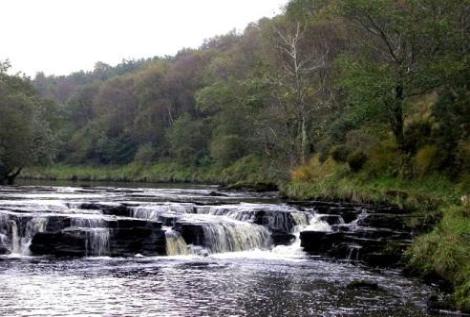
Eany River near Frosses
About one-third of all the rain that falls finds its way into rivers. Most of them start out as cascading mountain streams, and work their way down to the sea through rocky gorges, and across a whole variety of soils, silts and gravels. By the time they reach the lowlands they have begun to deposit mud and silt from higher up, and they become wider and smoother-flowing, often winding and meandering. For thousands of years they have been helping to carve and mould the landscape, and after a winter flood or storm you can see the evidence that they’re still very much in action. Many rivers have been confined and manipulated by drainage schemes to control flooding, but in Donegal we have lots of examples of lovely untamed rivers, like the Lackagh at Sheephaven or the Owengarve above Glenties, which still flow wild and free.
Two birds whose lives are completely attuned to the river are the cocky little Dipper and the dazzling Kingfisher. Dippers are found mostly in stony areas of rough water, constantly bobbing up and down, catching the eye with their bright white bib. They hunt for insect life and small fish along the water’s edge or under the surface, which is remarkable behaviour for a songbird. They plunge under the water, using their wings in a sort of slow-motion flight, and can walk along the riverbed, preventing themselves from bobbing up by angling their body very precisely against the current. They have even been known to hold a pebble in their feet as ballast. Look out for them around old stone bridges – one of their favourite nesting sites.
Kingfishers are more likely to turn up along the leafy lowland stretches of the river, with shady pools and overhanging branches. They’re so well known for their brilliant plumage that it can be surprising to discover that these flashy characters are not much bigger than a Sparrow. The birdlife of the river is constantly travelling up and downstream, so the best way to enjoy it is to sit still for half-an-hour and wait for the passing traffic. Grey Wagtails flickering yellow along the edge; stately Herons; pairs of Mallards gearing up for the breeding season; Moorhens skulking through the bankside vegetation – at this time of year there will nearly always be something on the move.
Seeing one of these agile sinuous bodies going about its business is always a real highlight of any river-watch. Otters are active all year round, and although largely nocturnal, they can turn up on the quieter stretches of many Donegal rivers at any time of day. A male Otter can patrol several miles of river, which will probably include the territories of more than one female. A pair will go around together for about a week during courtship, but then the male moves on and the female raises the family of two or three cubs entirely on her own. They will stay with her until they’re at least a year old. Most research on Otters is done by studying their droppings, or spraints, which they conveniently deposit on prominent stones or stumps. The strong distinctive smell is full of messages for other Otters who can probably detect the age and sex, and even the individual identity, of the owner. Some research has claimed to identify 100 different “scent components” in otter droppings.
The ribbon of natural woodland and plant life along the banks is a vital part of the living river. The whole “river corridor” is a web of relationships, from the tops of the trees to the riverbed, and the continuous cover in some parts could stretch back for a thousand years or more. Tree roots help to hold the bank together, leaves act as fertilizer, falling grubs feed fish, and fallen trees provide sheltered pools and hiding places. Research on some British rivers found that half of all their fish spawning grounds were created by fallen branches.
Up in the wooded mountain glens it’s mostly Birch, Rowan, Holly and stunted Oak. Lower down, the classic riverbank trees come into their own – Alder and various species of Willow, and on some Donegal rivers, the rare Bird Cherry which stands out in spring with its long hanging sprays of almond-scented white flowers. The Willows are a complicated family with lots of varieties and hybrids. Huge Crack Willows were often pollarded in the past to produce a regular harvest of poles. Osiers were a favourite for basket-making. Truly native willows include Eared Willow and Bay Willow in more upland areas, and Sally (Grey Willow) and Goat Willow in the lowlands. The Willows collectively support more biodiversity than any other tree in Ireland and Britain – for example, 450 different species of insects and mites. Oak comes second with 423 and Birch third with 334 species.
Riverbank vegetation can also contain a rich variety of flowering plants. But where banks have been disturbed by drainage schemes or gravel extraction, whole habitats can be lost, and sadly many Donegal rivers are now suffering badly from the rapid spread of invasive alien species such as Japanese Knotweed and Himalayan Balsam. These tough plants can cover huge areas and smother all plant life in their path.
Four to Find this Month:Blackthorn Flowers: Blackthorn has the unusual habit of putting out its clusters of delicate white flowers on bare branches, well before there’s any sign of a leaf. The dark bushes look as if they’re covered with a late layer of frost. |